 SMASHWORDS EDITION Copyright © 2004, Derechos Reservados - Dr. Jay Polmar Smashwords Edition, License Notes This ebook is licensed for your personal enjoyment only. This ebook may not be re-sold or given away to other people. If you would like to share this book with another person, please purchase an additional copy for each recipient. If you’re reading this book and did not purchase it, or it was not purchased for your use only, then please return to Smashwords.com and purchase your own copy. Instructions:1. Instructions: 1.
SMASHWORDS EDITION Copyright © 2004, Derechos Reservados - Dr. Jay Polmar Smashwords Edition, License Notes This ebook is licensed for your personal enjoyment only. This ebook may not be re-sold or given away to other people. If you would like to share this book with another person, please purchase an additional copy for each recipient. If you’re reading this book and did not purchase it, or it was not purchased for your use only, then please return to Smashwords.com and purchase your own copy. Instructions:1. Instructions: 1.
Before you read this book, practice your pronunciation by going to page 89. Listen and practic the sounds you hear. You will learn quickly by using this audio program (cassette or CD) while reading the sounds fro this book from pages 89 to 92. 2. After practicing the audio program at least seven times, continue on to read and study the Gringo Guide. Copyright 2004, Derechos Reservados - Dr. Sí estás leyendo esta guía, es probable que estés en México, y tienes la necesidad de hablar con otros en español. If English is your first language it must be difficult for you to comprehend why there are 16 potential tenses to the Spanish language. Si el inglés es tu primer idioma puede ser difícil para tí comprender porque hay 16 tiempos potenciales en el idioma español. In the Gringo Guide we present a variety of statements, verbs, and pronouns to help you speak in the present tense. La guía de gringos te presenta una variedad de oraciones, verbos, y pronombres, para ayudarte hablar en tiempo presente. In this way you can communicate your needs or wants, in the simplest possible form. De esta manera puedes comunicar tus necesidades o lo que quieras en la forma más simple posible. And by using our days and dates method, you can talk about the past and the future. Y al usar nuestros días y métodos de fechas, puedes hablar acerca del pasado y del futuro. Best of all, you can do it right now and study just a few minutes each day and soon you’ll be speaking Spanish. Lo mejor de todo, es que puedes hacerlo justo ahora y estudiar solo unos cuantos minutos cada día y pronto estarás hablando español. Keep the guide in your pocket or purse. Mantén la guía en tu bolsillo o en la bolsa. Whenever you need to talk to others in Spanish to get your needs met - just open to the right page and start talking. Cuando necesitas hablar con otros en español para obtener lo que necesitas - solo abre la página y empieza a hablar. Common phrases and idioms have been covered and we’ve also created scenarios and situations that you, as a tourist, might run into. Frases comunes y modismos han sido puestos y también hemos creado escenarios y situaciones que tú, como turista, puedas necesitar. Don’t forget to listen to the pronounciation tape and practice your pronounciation with this book before going out into the world of Spanish. No olvides escuchar la pronunciación y practicala con este libro antes de salir hacia el mundo del español.MEXICANS ARE
POLITE PEOPLE From my personal experience, Mexicans are very polite people. No olvides escuchar la pronunciación y practicala con este libro antes de salir hacia el mundo del español.MEXICANS ARE
POLITE PEOPLE From my personal experience, Mexicans are very polite people.
In the tourist areas the Mexican population is especially helpful and friendly. However, very few Mexicans have mastered talking in English. Thus, we always recommend responding politely in the Spanish language. Use the appropriate polite language, including Hello and Goodbye, Good Morning, Good Afternoon, Good Evening, and especially Please, Thank You and You’re Welcome:  MEXICANS ARE
MEXICANS ARE
POLITE PEOPLE LEARN
LEARN
YOUR NUMBERS The number “one” changes from “uno” to “un” before a masculine noun. i.e., one book-un libro, one man-un hombre. i.e., one pen-una pluma, one girl-una chica When counting generically (one, two, three ...) use “uno” but when counting specifically (one cat, one dog), use “un” or “una.”: one book - un libro, one pen - una pluma.
The number “one” changes from “uno” to “un” before a masculine noun. i.e., one book-un libro, one man-un hombre. i.e., one pen-una pluma, one girl-una chica When counting generically (one, two, three ...) use “uno” but when counting specifically (one cat, one dog), use “un” or “una.”: one book - un libro, one pen - una pluma.
 LEARN
LEARN
YOUR NUMBERS NUMBERS: Here are some more examples: 142. ciento cuarenta y dos 375. trescientos setenta y cinco 612. seiscientos doce 907. novecientos siete 999. novecientos noventa y nueve Remember from an earlier lesson, there is a masculine and a feminine form for the number one: This is also true for the numbers 200, 300, 400, etc.
This is also true for the numbers 200, 300, 400, etc. When there is exactly 100 of something, and the number is used with the noun, use the shortened form “cien.”
When there is exactly 100 of something, and the number is used with the noun, use the shortened form “cien.”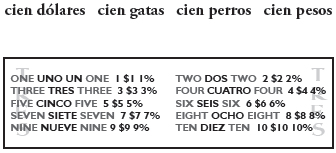 TELLING TIME
TELLING TIME NOTE: The verb ser is used to express the time of day. novecientos noventa y nueve Remember from an earlier lesson, there is a masculine and a feminine form for the number one:
NOTE: The verb ser is used to express the time of day. novecientos noventa y nueve Remember from an earlier lesson, there is a masculine and a feminine form for the number one:  This is also true for the numbers 200, 300, 400, etc.
This is also true for the numbers 200, 300, 400, etc.  When there is exactly 100 of something, and the number is used with the noun, use the shortened form “cien.”
When there is exactly 100 of something, and the number is used with the noun, use the shortened form “cien.”  TELLING TIME
TELLING TIME NOTE: The verb ser is used to express the time of day.
NOTE: The verb ser is used to express the time of day.
Use es when referring to “one o’clock” and use son when referring to all other hours. It’s one o’clock. - Es la una. It’s two o’clock. - Son las dos. Minutes can be added to the hour
by simply using the word y (and): It’s five minutes past one. Es la una y cinco minutos.
It’s fifteen minutes past three. Son las tres quince. You can also use the words media (half ) It’s half past one. - Es la una y media. It’s quarter to three. To say something occurs at a specific time,use the formula a + la(s) + time The party begins at one o’clock. To say something occurs at a specific time,
Página siguiente
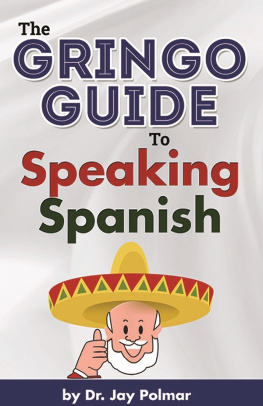
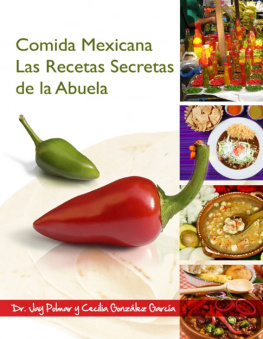



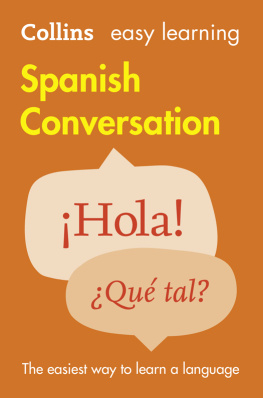
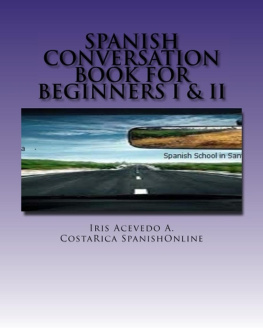
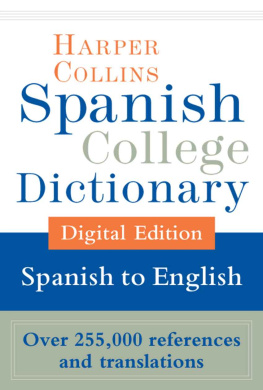

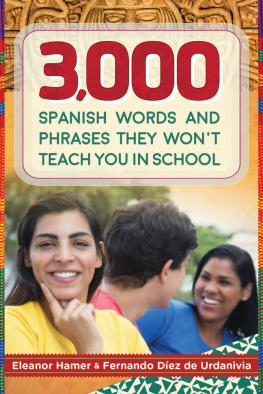

 SMASHWORDS EDITION Copyright © 2004, Derechos Reservados - Dr. Jay Polmar Smashwords Edition, License Notes This ebook is licensed for your personal enjoyment only. This ebook may not be re-sold or given away to other people. If you would like to share this book with another person, please purchase an additional copy for each recipient. If you’re reading this book and did not purchase it, or it was not purchased for your use only, then please return to Smashwords.com and purchase your own copy. Instructions:1. Instructions: 1.
SMASHWORDS EDITION Copyright © 2004, Derechos Reservados - Dr. Jay Polmar Smashwords Edition, License Notes This ebook is licensed for your personal enjoyment only. This ebook may not be re-sold or given away to other people. If you would like to share this book with another person, please purchase an additional copy for each recipient. If you’re reading this book and did not purchase it, or it was not purchased for your use only, then please return to Smashwords.com and purchase your own copy. Instructions:1. Instructions: 1. MEXICANS ARE
MEXICANS ARE LEARN
LEARN The number “one” changes from “uno” to “un” before a masculine noun. i.e., one book-un libro, one man-un hombre. i.e., one pen-una pluma, one girl-una chica When counting generically (one, two, three ...) use “uno” but when counting specifically (one cat, one dog), use “un” or “una.”: one book - un libro, one pen - una pluma.
The number “one” changes from “uno” to “un” before a masculine noun. i.e., one book-un libro, one man-un hombre. i.e., one pen-una pluma, one girl-una chica When counting generically (one, two, three ...) use “uno” but when counting specifically (one cat, one dog), use “un” or “una.”: one book - un libro, one pen - una pluma.
 LEARN
LEARN This is also true for the numbers 200, 300, 400, etc.
This is also true for the numbers 200, 300, 400, etc. When there is exactly 100 of something, and the number is used with the noun, use the shortened form “cien.”
When there is exactly 100 of something, and the number is used with the noun, use the shortened form “cien.” TELLING TIME
TELLING TIME NOTE: The verb ser is used to express the time of day. novecientos noventa y nueve Remember from an earlier lesson, there is a masculine and a feminine form for the number one:
NOTE: The verb ser is used to express the time of day. novecientos noventa y nueve Remember from an earlier lesson, there is a masculine and a feminine form for the number one: